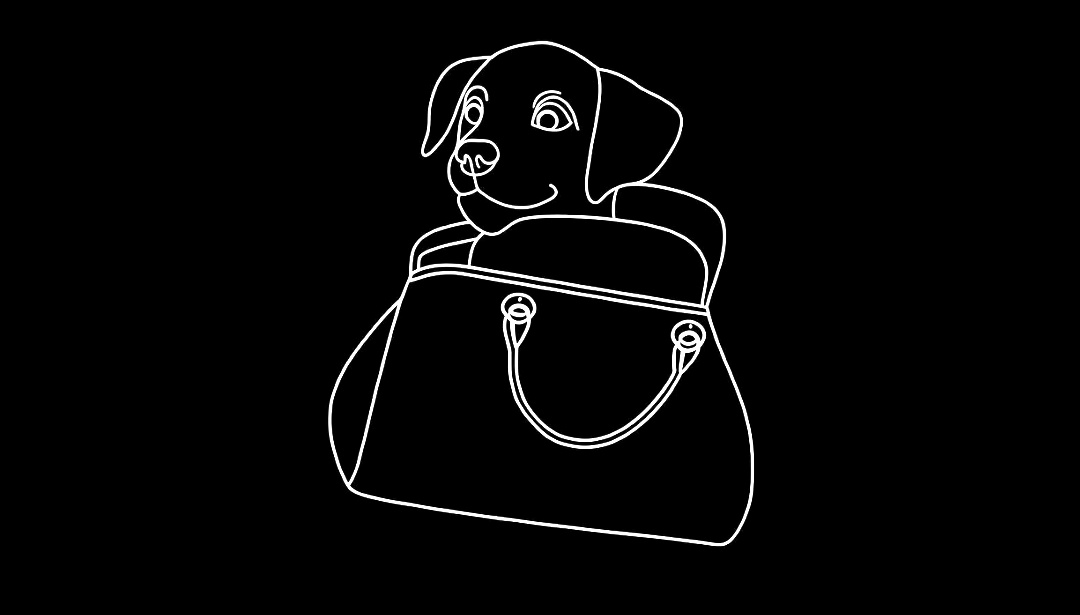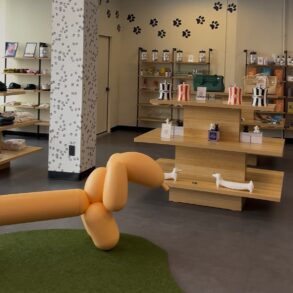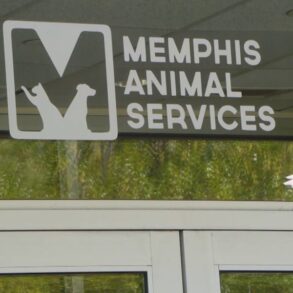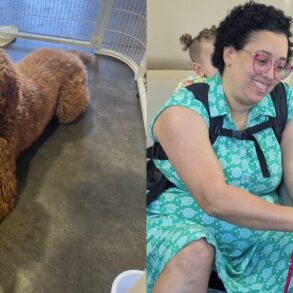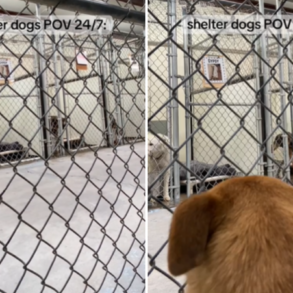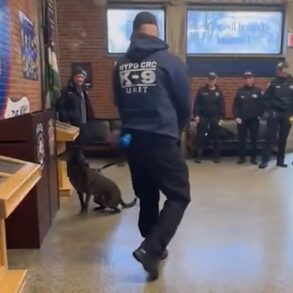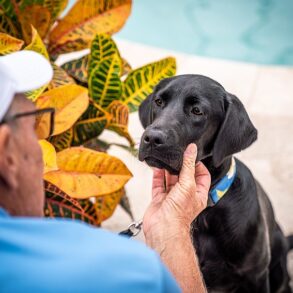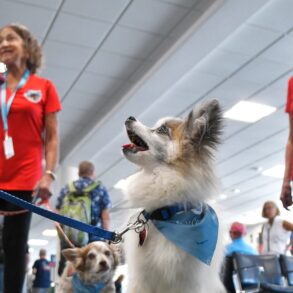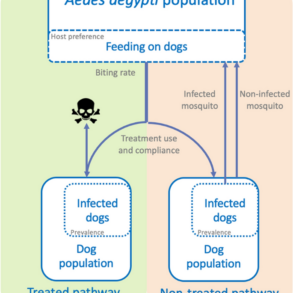Malena DeMartini doesn’t want to say that return-to-office mandates have been good for business because there’s nothing good about the prospect of dogs suffering. But as a dog trainer who specializes in separation anxiety, she’s recently been inundated with clients. After years of having their owners around all day, many pets aren’t accustomed to being alone anymore — some have never spent any time solo at all. So when the boss says it’s time to pack it in on remote work, many people are caught flat-footed, and their animals are paying the price.
“I won’t sugarcoat it. It’s much harder if people haven’t prepared in advance,” she said. “Keep your little furry friend in mind because it’s a drastic transition.”
Unfortunately, many pet owners have slept on the preparedness front. Their employers are demanding they come back to the office, and even the most understanding of managers may not be super open to “my dog will be sad” as a valid excuse for a permanent work-from-home exception. This has left people to scramble to figure out what to do with their pets, many of which are not accustomed to spending long stretches of time by themselves. Concerned owners are signing their dogs up for day care, rushing to find walkers and sitters, and buying treat-dispensing video cameras they hope will calm their pets’ nerves (and their own). For those who have yet to get an RTO order, DeMartini recommends acting like one is coming anyway. Teach your dog to be by itself now, before you’re panicked about whether your little guy will destroy your couch as retribution for your 9-to-5.
The pandemic pet conundrum has become a familiar story: Lonely people stuck at home in 2020 decided it was an opportune time to get a new dog or cat, figuring that they finally had time to dedicate to such an endeavor. In one American Society for the Prevention of Cruelty to Animals survey of US residents, one in five respondents said their household got a cat or dog between March 2020 and May 2021.
“We had more people who wanted to foster or adopt than we had pets in the shelters, which was incredible to see,” said Tori Fugate, the director of communications for Shelter Animals Count, a national database for animal rescues and shelters.
Dogs don’t know how to dog
Adrienne Preuss, the owner of Animal Loving Care, a dog day care and boarding facility in Brooklyn, New York, said that while the pandemic brought about a “huge surge” in people getting pets, a lot of these new owners made “spur-of-the-moment decisions” and weren’t prepared for what came next. Her business started offering remote dog training and sending instructional videos to clients who were struggling with their new wards.
“We had a lot of puppies that came in during that time with behavioral issues for a number of reasons. The biggest reason was that people were not leaving them at any period of time, so they were either with the owners constantly at home or with us,” she said. “There was no period of time where they were not with humans, and that’s not ideal for setting up a dog to feel confident being by themselves.”
Then, as the pandemic eased and people returned to their normal lives — going out to dinner, taking vacations, and easing their way back into the office — they were confronted with a crop of pets who had no idea how to make do on their own. As the return-to-office push has continued, more and more pet owners are finding themselves in a pickle. Serveral major companies are trying to strong-arm their workers back into the office: AT&T, Citigroup, and Dell are telling employees to come in full time, and others, including Apple and Starbucks, are requiring part-time in-office work. President Donald Trump has ordered federal agencies to get people back into the office, too. In addition to all the other disruptions of the RTO orders, pet owners are concerned their dogs have separation anxiety, and even if he doesn’t, Fido may not be jazzed about staying home alone — or able to do so responsibly.
“Dogs don’t know how to dog,” said Kate Meghji, the chief operating officer of the Humane Rescue Alliance, an animal-service provider based in Washington, DC.
Jacob Hensley, the founder of District Dogs, a dog day care in Washington, DC, said he sees an influx of new clients whenever a big return-to-office mandate hits the area. This year already, he saw a jump in account creations and new reservations as Amazon started requiring people to come in five days a week in January, and he’s seeing even more now as federal workers are being told to show up in person. He’s also getting clients as people move to the area because of RTO asks.
“Whenever we see a new customer, the majority of the conversations talk about” a return to the office, he said.
In 2023, District Dogs opened a location at Amazon’s HQ2 campus in Arlington, Virginia, to help accommodate (and pick up business from) employees going into the office. Hensley is now in discussions with a large employer in the Washington, DC, area to put together some sort of dog day care benefit for employees coming back to the office. “We are living in a fur baby age,” he said.
You don’t have to do a deep dive into Reddit to find examples of workers fretting about what to do with their beloved pets while they spend the day putting in their time with The Man. “Anyone else concerned about what they’ll do with their pets if they’re gone 10 or more hours a day commuting with RTO?” one Redditor wrote in January on a forum for federal employees.
So what, exactly, is one to do?
Sending your dog to day care is a decent option for workers, but it has its limitations. For one thing, it’s expensive. District Dogs in Alexandria, for example, charges $50 a day, as does Animal Loving Care, though they give discounts for packages. For many people, sending a dog to day care five days a week isn’t feasible, not only because of costs but also because the dog may not want to be there. If the pet hasn’t been socialized correctly, it might not take well to day care, and even if it has, older dogs tend to age out of day care enjoyment.
DeMartini said we’re “only limited by our creativity” with finding people who can watch dogs at little or no cost. She suggested reaching out to retirement communities to see whether they might benefit from a furry friend from time to time or calling up a family member, friend, or neighbor who has more spare time. There are always dog walkers, but again, that can get expensive, and your walker probably isn’t going to spend eight hours with your pet. You can also ask about bringing your dog to work, but your manager and your coworkers may not be open to it.
The worst-case scenario is, of course, that someone winds up renouncing their pet because they feel they can’t make it work. Shelter Animals Count, which tracks animal rescues and shelters across the US, found that 5.8 million pets were taken in by shelters and rescues in 2024, which is still below the prepandemic level but a jump from the pandemic low of 5.3 million in 2020. When pets do land in a shelter, it’s now taking them longer to get adopted than in 2020 when they were getting scooped up, which is leaving shelters overwhelmed.
Fugate said that it’s not clear whether RTO has been a major driver of pet returns. It’s often economic factors (vet bills and food are expensive) or because of housing problems — many places don’t accept pets. Preuss from Animal Loving Care said that she saw an “unprecedented level” of people giving away pets in the wake of the pandemic but that things had normalized since that time.
Even those who keep their dogs now may be hesitant about adopting again if they have a negative experience. Meghji said that people generally seem “pretty committed” to working with their pets and modifying their lifestyles, even amid behavioral challenges, but she worries about “what that means the next time they’re thinking about getting a dog.”
No matter how unprepared your pandemic pup may be, every animal behavior expert and day care owner I spoke with for this story said it’s critical for a pet to be able to be by itself for at least some chunks of time. It might take some practice and effort (or a lot) and some development of a routine, but in the long run, it’s good for a dog to be able to self-soothe and have some me time.
If you’re worried about your pet being at home alone, it’s important to figure out whether they’re actually suffering from separation anxiety, which is a clinically diagnosed condition, or the problem is something else. People have a tendency to attribute everything their animal does that they don’t like to anxiety, even when that may not be the root cause.
Separation anxiety can manifest in various ways. Some dogs bark or howl endlessly. Some try to escape. Some destroy things. Others will urinate or defecate out of worry. Katherine Houpt, a professor emeritus of animal behavioral medicine at Cornell University College of Veterinary Medicine, said the best thing pet owners can do is to get a camera so they can see how their dog is reacting when they leave. That may also help them figure out whether what’s happening is even separation anxiety — your dog might tear up your apartment because it’s sad you’re gone, or it might do it because it’s bored and destruction is fun. Houpt worked with one dog whose owners thought he had separation anxiety, but video revealed he was playing — he took a couch cushion, tore it apart, rolled around in it, and at one point grabbed a toilet bowl brush to seemingly stir the escaped couch feathers.
He’s learned that when you leave, the world doesn’t come to an end and that you always come home
There are tactics people can deploy to ease their dog’s stress if they do indeed have separation anxiety. Talking to a dog via video camera or leaving on videos tailored to dogs doesn’t seem to do much, Houpt said. Getting your dog a friend might help, but the animals might fight, or you might just wind up with two anxious pets. It may also help to give the dog a special treat it takes a long time to eat when you leave, though if it really has separation anxiety, it might not eat while you’re gone. And there are always medications — fluoxetine (Reconcile) and clomipramine (Clomicalm) are Food and Drug Administration-approved for separation anxiety.
“If the dog is good for six months, I’d treat him for another six months and then try weaning him off, and it may be fine,” Houpt said of using the drugs. “He’s learned that when you leave, the world doesn’t come to an end and that you always come home.”
If you suspect your pet has separation anxiety, you may want to get pet insurance and wait on a diagnosis if you can so the insurance will cover it and it won’t be determined to be a preexisting condition.
To be sure, there are other steps between quitting your job so your dog isn’t alone and medicating your dog so it can make it through the day. A lot of it is a matter of practicing alone time.
“Teaching the dog to stay, as simple as it sounds — it is really curative because many of these dogs have never had to inhibit themselves,” Houpt said.
DeMartini recommends exposing dogs to small amounts of alone time so they get used to the idea that people will go away and come back. First, one minute, then three, then five, and so on, until, eventually, you can leave for varying lengths of time, though progress may not be linear.
“While it sounds like, ‘Wow, it’s going to take five years to get my dog to be left alone,’ it’s a little bit more like compounding interest,” she said. “It’s very similar to exposure therapy that we’ve used with humans.”
Preuss from Animal Loving Care also pressed the importance of crate training, even if you think your dog doesn’t need it. “Even if your dog is great out of the crate, it’s a really essential and useful resource to have,” she said. “We have dogs that come in to us who’ve never seen a crate in their life, so they can’t even be separated in the environment to eat.”
If and when you do wind up going to work and leaving your dog behind, when you get home, don’t make a big deal about it. If you do an exaggerated, enthusiastic greeting and play and get the dog all excited, it’ll turn that into the highlight of its day — and make the time when you’re gone worse.
Teaching the dog to stay, as simple as it sounds — it is really curative because many of these dogs have never had to inhibit themselves
As an aside here, cats are a bit of a different story. If a cat has separation anxiety, it might go unnoticed, DeMartini said, because their outward behavior, something like hiding away or drooling, isn’t really impactful on their owner. Houpt said she’d never seen a clinical case of a cat with separation anxiety, though people say they exist. But she noted they’re generally a more solitary species and don’t mind being alone a lot of the time. (If you have a cat, you probably know this.) She also recommended making sure the animal doesn’t have some sort of underlying medical condition.
“Yes, the cat is pulling its fur out, but it probably has a dermatological problem, not a psychological problem,” she said. “But set up your camera and see if the cat is spending four hours glued to the front door. Then maybe you do have a problem.”
The push and pull between employers and employees to get work back into the office is not going away. As companies feel they have more leverage, many will do what they can to get workers back in. And workers who have become accustomed to the flexibility of remote and hybrid arrangements will continue to resist. Pets are unwittingly caught up in the battle.
But even if you think your boss will be cool with you working from home forever, it’s a good idea to get around to teaching your dog to exist comfortably without you around sooner rather than later. Employers are sure to keep pushing on RTO, and regardless, you probably should be able to go to the grocery store or happy hour without your pup having a meltdown.
Emily Stewart is a senior correspondent at Business Insider, writing about business and the economy.
Business Insider’s Discourse stories provide perspectives on the day’s most pressing issues, informed by analysis, reporting, and expertise.
This post was originally published on this site be sure to check out more of their content.
